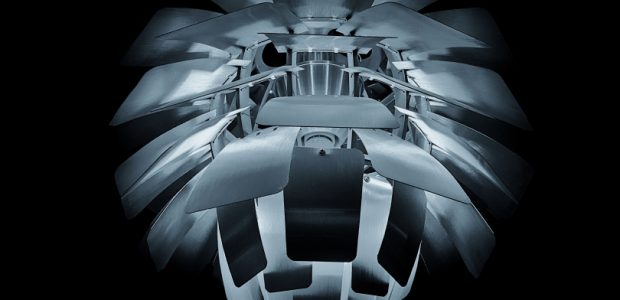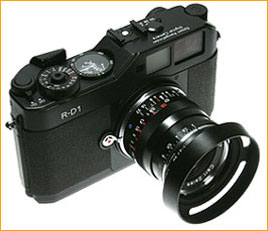
Photo Courtesy Epson UK
Some History
My first career was as a photojournalist. I spent a large part of my professional life traveling the world with a Leica M3 and M2, and then M6 and finally M7. In prior years I’ve written extensively about rangefinder cameras, lenses, accessories, and the rangefinder esthetic, both here on my web site as well as for magazines. I even did a series of program segments forThe Video Journalabout the use of rangefinder cameras in doing documentary photography.
But, in late 2002 I sold my Leica M cameras and lenses. I’d decided that I wasn’t going to shoot film any more, and Leica had then recently announced that for technical reasons they would be unable to make a digital M series camera.
So, with a lot of regret, and not a small financial shellacking, I sold my Leica M6, M7, Bessa T, and assortment of superb Leica and Voigtlander glass, and used the proceeds to finance the purchase of a Canon 1Ds.
There were regrets, to be sure, though none over having left film behind. That was a non-issue. If I never shot another roll of film, had to work in the darkroom, or needed to do scans again, it would be no loss. But I did miss working with a rangefinder camera. I tried various digicams in an attempt to find something small, light and responsive for street and documentary shooting, but in the end found electronic viewfinders to be truly dreadful when compared with the visibility afforded by an SLR, let alone the eyes-wide-open viewing and composing ability of a rangefinder. Responsiveness? Forget it.
But I soldiered on, using a mix of digicams and small DSLRs for those times when I would otherwise have shot with a rangefinder.
When I read the reports from Photokina ’04 about Epson’s R-D1 digital rangefinder camera with a Leica M lens mount, I was at once fascinated, annoyed, curious, and apprehensive. How had Cosina and Epson managed to pull off what the legendary optical gurus at Leica had declared impossible? Was this a sham? Would it really come to market? And, what was with the fact that the R-D1 had a wind lever? Was this just a retro nostalgia conceit?
Over the ensuing months the R-D1 dropped below my radar, until I publishedSean Reid’s reviewand follow-upwide-angle lens report. Maybe there was something here after all. But with a price of US $3,000, and no local dealer carrying one for me to casually inspect, I managed to suppress any nascent desire in the bud.
Then in February, 2005 thePMAshow rolled around, and I found myself in the Epson booth. The R-D1 display area was quiet, and I had a chance to spend a good twenty minutes handling and examining and R-D1 closely.
Holy coincident rangefinders Batman, this is one serious camera! The "feel" was as confident as any M Leica that I’d used in the previous thirty years. The optical viewfinder is big and bright, and life-size (1:1), while materials and build quality were excellent, though not quite up to Leica standards.
As soon as I got home I contacted Epson and requested a review sample. It arrived along with aVoigtlander 35mm f/2.5 Color-Skoparlens the afternoon before I was to leave on a shoot in the Florida Everglades. I’d set the afternoon aside to prepare my camera gear (medium format), and to pack. But it wasn’t until well into the evening that I got around to these tasks because the next few hours were spent handling, studying and shooting around the house and around the block with the R-D1. My initial impressions were very positive.
So with this as long-winded background, the following are my more long-term impressions of the Epson R-D, following a week of field use and several hundred frames.
Note that this is not a review, and therefore if you want to know more about the basics of the R-D1 I recommend that you read Sean’s review first.
______________________________________________________
Ergonomics
When it comes to actually shooting (the whole digital / film issue aside for the moment), the camera is mostly a pleasure to use. This assumes though that one is used to the rangefinder esthetic. Frankly, unless one has grown up with or extensively used a real rangefinder camera, this is likely not to be the case. For a photographer used to SLRs the chances are that using the R-D1 (or any rangefinder for that matter) is going to be found to be a funky experience.
But assuming that one knows what the breed is all about, there really isn’t that much difference between shooting with the R-D1 and a Voigtlander Bessa or even M Leica.
That’s the good news. The bad news is that the world has now moved on, and I’m not really sure that some of the rangefinder conceits, and R-D1 implementations of these paradigms, still make sense in a digital world.
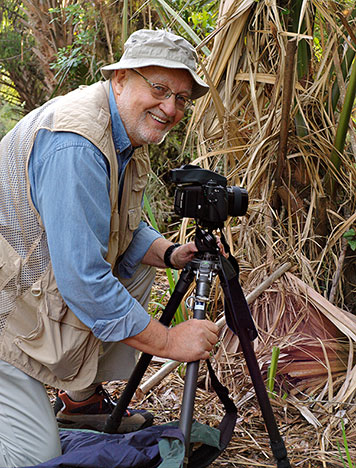
Jack Perkins. Along the Myakka River, Florida. March, 2005
Epson R-D1 with Voigtlander 35mm f/2.5 lens at ISO 200
______________________________________________________
Framing
Let’s take the most obvious aspect of this camera, the viewfinder with split image rangefinder. This is still a very enjoyable way to work. The scene being viewed is bright, and in the case of the R-D1, life-sized. This means that you can shoot with both eyes open (assuming that you’re right-eyed). The bad news is that with a 1:1 viewfinder only the 35mm and 50mm frames are easily viewable. With glasses the full 28mm frame can’t be seen, though a custom screw in diopter from ones optician would mostly solve this problem.
More to the point though is that because of its smaller-than-full-frame chip, the 28mm lens and frame lines are really 42mm, the 35mm are really 53mm, and the 50mm frame is 75mm. Whether or not this is a problem for any given photographer will very much depend on their needs and usage preferences. For me though, a rangefinder is a close-in and wide-angle camera. My ideal lens on the Leica was always the 35mm.
So here’s the problem. To get comparable coverage one needs to use either a 21mm lens (32mm angle of view), or a 25mm lens (38mm angle of view). There is some fine glass available in these focal lengths, but the rub is that an auxiliary viewfinder is needed. These are available, but they’re not for me. I find using a coincident rangefinder to bemuchslower than the autofocus that I’ve become used to with SLRs, and when an auxiliary viewfinder is also used, framing and focusing become even slower and more cumbersome.
Some experienced rangefinder users will reply –zone focus. Yes, but; with thebutbeing that I tend to shoot with a rangefinder in places and at times when light levels are low, and therefore lenses are used wide open. It simply doesn’t work for me.
______________________________________________________
Controls
The R-D1 really breaks with the contemporary design paradigm, and Epson and Cosina are to be given credit for daring to be different. Whether or not these differences translate into increased usability is another matter though.
Rather then list the things that I liked, let me mention mostly the things that I didn’t like, and you can assume that if it isn’t on this list that it passes muster.
– The ISO setting is accomplished with a traditional lift-the-ring-around-the-shutter-speed-dial-and-twist . So far so good, and vastly superior to the way most contemporary DLSRs are designed, where the ISO setting is buried beneath a layer of on-screen menus and button presses. But the ISO numbers engraved on the R-D1 are small, and are buried deep inside a recessed window opening, making them hard to read. Everyone I showed them to expressed similar concern.
– The analogue dial window on the top of the camera is a lovely design, and once one becomes familiar with its unconventional appearance it does the job well. The frame line setting knob has solid detents and is unlikely to be accidentally shifted, and similarly the Image Quality and White Balance setting controls are simple intuitive. Excellent design.
– I’m less enamoured of the wind lever. Frankly, I find this to be simply a retro affectation, and after a week of working with the R-D1 it was no longer cute. It was a pain.
Some have said that it serves the function of slowing one down so as to work more deliberately. Sounds good, but more often than not it slowed me down to the extent that I missed "the moment". Leica users added rapid wind attachments and motor drives so as to be able to shoot faster and more responsively. Now we have a digital camera which could easily have a micro-motor cock the shutter, but which chooses instead to make it manual. Sorry, but it doesn’t work for me.
– I was also disappointed with battery life. After just a couple of hundred shots the battery was showing low. Though I didn’t do any rigorous tests, it seems to me that since Epson has harnessed my thumb to cock the shutter, and doesn’t even provide instant image review, the trade-off should have been better battery life.
______________________________________________________
Digital Functions
There are a few gripes, though on the whole the R-D1 manages to integrate its digital functionality well with its traditional design brief.
The first of these is that there is no instant review of the image shot. You have to wait until the shot has been saved to the SD card and then must press a button to call up the image.
The second is that while you can elect to have the screen display flashing highlights or a histogram on post-exposure review, the camera forgets this settings when powered down, and so if one or the other is your usual preference you’ll find yourself constantly fiddling with the controls to reset these functions.
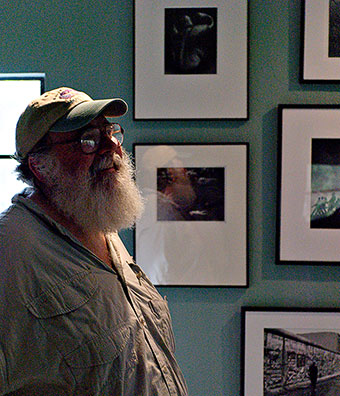
Clyde Butcher. Big Cypress, Florida. March, 2005
Epson R-D1 with Voigtlander 35mm f/2.5 lens at ISO 800
Because of this I found myself using the camera with the LCD folded closed, much as I would a traditional film camera. That’s fine, but there were times when I was concerned about optimizing the exposure, such as the shot of photographerClyde Butcher, as seen above, taken at his home inBig Cypress Reserve. The light levels were very low, the back light from the window very strong, and consequently I was concerned about properly holding the dynamic range.
On a camera with an instant review histogram I would have taken a test frame, optimized the exposure, and then shot with confidence – all within just a few seconds. The R-D1 doesn’t lend itself to that type of shooting though, and so this exposure turned out to be less than optimum, requiring a lot of post processing to end up with a usable image.
______________________________________________________
Image Quality
Image quality is in my experience a mixed bag. At ISO 200 (the camera’s lowest setting, even though the manual shows an illustration with an ISO 100 setting), noise is almost nonexistent. At 400 it is noticeable, though not a problem. At ISO 800 it starts to become problematic, and at ISO 1600 it is not in the same league as the Canon 20D, for example.
I did like the colour rendition though. It has a somewhat pastel look, reminiscent ofFuji Astiafilm. This can be seen in the portrait of Jack Perkins, higher up the page, though I did punch it up a bit in this instance, because when used in the shade I find the R-D1 to be a bit too desaturated for my taste.
______________________________________________________
Software
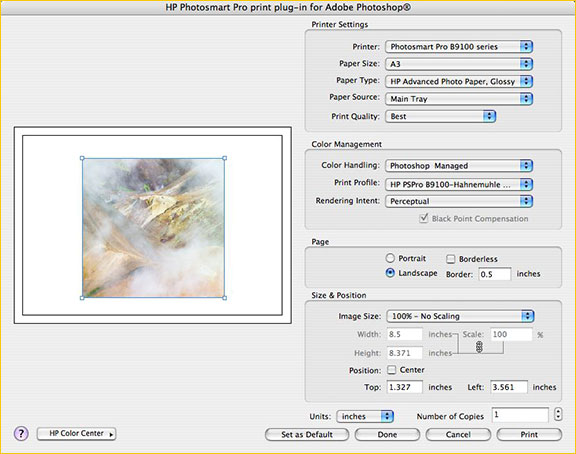
The R-D1 comes with raw processing software for both Macs and PCs. The PC gets both a stand-alone program and a Photoshop plug-in, while the Mac gets only the plug-in. Since I’m primarily a Mac user, I only tested the Mac version of the plug-in.
It’s competent, but not full-featured. For example, there’s no browser. Also, the Output settings, where you select sRGB or Adobe RGB, or 8 bit vs 16 bit mode, does not have sticky settings. This means that you have to set these separately each and every time that you convert a file. Tedious to say the least. I could live with it though, because the image quality that the software produces is very good.
______________________________________________________
Final Assessment
I know several very experienced photographers who have bought an Epson R-D1, and who love it. I’m told of one fine-art photographer who has sold all his Canon DSLR gear in favour of the simplicity of the R-D1 and a few lenses. I can well understand this.
As serious photographers each of us has our own style, needs and preferences. Though I spent decades working with M Leicas, the current Epson / Cosina digital iteration of this breed turns out not to be for me. My reasons why are only partially explained by some of my beefs above, and frankly most of them are minor.
It simply turns out though that even after a period of intensive use and many hundreds of frames, I couldn’t bond with this camera. I had the opportunity to continue to work with it for a longer period, and I have access to other M-mount lenses, but in the end I returned the review sample after a couple of weeks with my thanks, but no regrets.
Maybe when Leica shows itsDigital Min a year or two the rangefinder spark will be rekindled in my heart. But for now I find the R-D1 to be have been the subject of a brief infatuation, but not captivating enough for a long-term relationship.
______________________________________________________
You May Also Enjoy...
Are the New iPhones all They’re Cracked Up to Be?
FacebookTweet When news of the new iPhones – the XS Max, XS, and XR – was announced last month, I wasn’t all that excited. Compared
